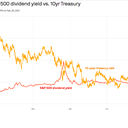Breaking down the rare convergence of the 10-year Treasury yield and S&P 500 dividend

A milestone was reached in the markets Thursday: The yield on the 10-year Treasury note rose to match the dividend yield on the S&P 500
Why it matters: The two yields have been inverted since the beginning of last year, which is historically unusual.
How it works: The 10-year Treasury note is a risk-free asset: If you hold it for 10 years, you know exactly how much it's going to return. Right now, that yield is 1.52%.
- The S&P 500 dividend yield is normally lower than the risk-free rate. Investors earn less in dividends than you would holding the same amount of money in Treasury bonds, but they hope that rising stock prices will make up the difference.
Context: The Treasury yield was artificially depressed by the flight-to-quality trade during the coronavirus pandemic, as well as by large-scale purchases by the Federal Reserve. Now yields are rising on optimism that aggressive fiscal policy might reignite inflation.
The big picture: Much of the rise in the S&P 500 has been driven by high-growth technology stocks. Like all stocks, they're valued according to the net present value of their future earnings — but unlike most stocks, a very large part of today's valuation is arrived at by extrapolating earnings out by more than 10 years.
- Those values are arrived at using what's known as a discounted cashflow calculation, where future earnings are discounted by a "discount rate." As interest rates rise, the discount rate goes up and the present value of the future earnings goes down.
The bottom line: As interest rates rise, that's naturally going to apply downward pressure to stock prices — especially when it comes to white-hot emerging tech stocks.
- For evidence, look no further than Thursday's 2.5% drop in the S&P 500, which was led by a sell-off in tech shares — and global bonds.